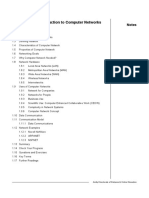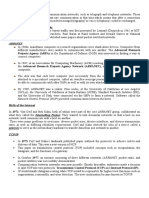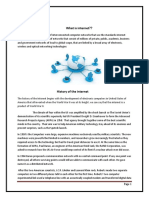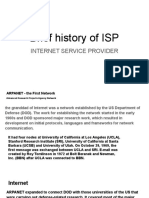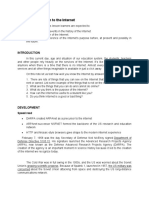Xyryz O.
Patagnan Assignment on Networks and Communications G035
1. Research the development of ARPANET and its impact on the internet
ARPANET (Advanced Research Projects Agency Network) is considered the first computer
network that employed the use of packet switching to connect to computers far apart from
each other geographically, and it is due to this network that birthed many of the protocols being
used by networks to this day, and it is thanks to it that we have what we know of as the internet
today. The network was developed by America’s Department of defense during the 60’s and 70’s
as a tool to help academic endeavors by connecting various academic institutions and
researchers. This was thus funded by the government in hopes to use this as a reliable and
decentralized form of communication for not only academic but also military purposes.
In the 1960’s, connection between computers or rather mainframes as it was prevalent
back then, was done over dedicated connective links which made these networks highly
centralized and prone to fail. People would sit at terminals called teletype machines and run
programs over. These systems were also very expensive hence why only academic institutions
and the military had hold and use of these systems. As the Cold War loomed over the USA,
desires and concerns for sharing resources and information across the nation more effectively
grew, which led to the military and universities vying for a more resilient network. Key
significant work included concepts such as packet communication which was developed by Paul
Baran and ideals of computer networks aiding decision making pioneered by Joseph C.R.
Licklider a then director of ARPA’s Information Processing Techniques, a proponent of human-
computer interaction development.
In 1966, Robert Taylor, the new director of IPTO, lead by his frustration of moving to
different terminals connected to different mainframes lead to the idea of a single network that
is accessible from any terminal. Development of key standards occurred such as NCP (Network
Control Program) handling Telnet and FTP (File Transfer Protocol), and IMP (Interface Message
Protocol) as early routers. The first message that was partially sent happened during 1969, by a
student of University of California Los Angeles Charley Kline, he was successful in typing the
characters “L” and “O”, but the computer abruptly crashed at the character “G’ of the “LOGIN”
command. With the effort of four universities, UCLA, Stanford Research Institute, University of
California Santa Barbara, and Utah School of Computing, they formed the initial work for
ARPANET that led to rapid expansion but issues arose such as interoperability. TCP/IP was
developed in 1977 that solved the issues, becoming the internet’s core technology in use, and
on January 1, 1983, TCP/IP fully replaced NCP on the ARPANET. In 1983, ARPANET split into
MILNET, as military use, and civilian use with the coined term “INTERNET”. By mid-1980’s,
ARPANET’s importance decreased, and in 1986 the NSFNET became the backbone of the
internet and paved way for the commercial network providers.
� ARPANET was a pivotal moment in computing. It birthed core internet technologies like
Telnet, FTP, and TCP/IP, and saw the first network email (1971) and spam (1978). ARPANET also
pioneered listservs (early social networks), voice communication protocols, password
protection, and data encryption.
2. Compare LAN, WAN, and MAN in terms of speed, cost, and application
MAN (Metropolitan
Feature LAN (Local Area Network) Area Network) WAN (Wide Area Network)
Lower (1 Mbps to 100
Speed
Very High (Gigabit Ethernet, Moderate (100 Mbps Mbps, but improving with
Wi-Fi 6) to 1 Gbps) technologies like 5G)
High (significant
Moderate (higher investment in long-
Low (relatively inexpensive cost due to distance connections and
Cost hardware and setup) infrastructure needs) equipment)
- Internet (connecting
- Connecting multiple networks globally)
- Home networks (sharing
offices within a city
internet, printers, files) - Connecting branch offices
- City-wide Wi-Fi across countries
- Office networks (internal
networks
communication, resource - Cloud computing services
sharing) - School/campus - Cable TV networks
- Large corporations with
networks
Application - Telephone company geographically dispersed
s - Small business networks networks locations


